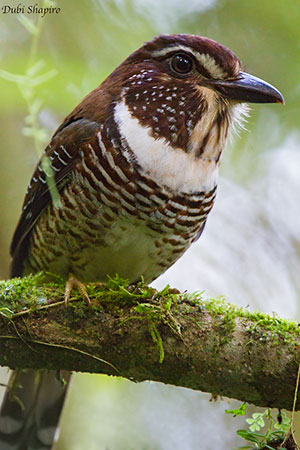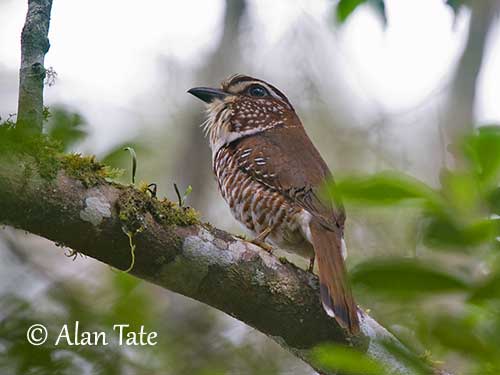
Fr: Brachyptérolle leptosome
Ang: Short-legged Ground-Roller
All: Bindenerdracke
Esp: Carraca terrestre paticorta
Ita: Coracia terragnola zampecorte
Nd: Gebandeerde Grondscharrelaar
Sd: tjocknäbbad markblåkråka
Mal: Famakiakora, Fandikalalana, Fangadiovy, tsakoko
Photographers:
John Anderson
John Anderson Photo Galleries
William Price
PBase-tereksandpiper & Flickr William Price
Dubi Shapiro
Dubi Shapiro Photo Galleries & Dubi Shapiro's Pictures on IBC
Alan & Ann Tate
AA Bird Photography
Text by Nicole Bouglouan
Sources :
HANDBOOK OF THE BIRDS OF THE WORLD Vol 6 by Josep del Hoyo-Andrew Elliott-Jordi Sargatal - Lynx Edicions, 2001 - ISBN: 848733430X
Wildlife of Madagascar par Ken Behrens,Keith Barnes - ISBN: 140088067X, 9781400880676 – Editeur: Princeton University Press, 2016
Birds of Madagascar: A Photographic Guide Par Pete Morris, Frank Hawkins – ISBN: 0300077556, 9780300077551- Editeur: Yale University Press, 1998
The Birds of Africa: Volume VIII: The Malagasy Region: Madagascar, Seychelles, Comoros, Mascarenes - Par Roger Safford, Frank Hawkins – ISBN: 1408190494, 9781408190494- Editeur: A&C Black, 2013
Birds of Madagascar and the Indian Ocean Islands Par Roger Safford, Adrian Skerrett, Frank Hawkins – ISBN: 1472924118, 9781472924117- Editeur: Bloomsbury Publishing, 2015
Creagus - GROUND-ROLLERS Brachypteraciidae
Wikipedia, the free encyclopaedia
Short-legged Ground-Roller
Brachypteracias leptosomus
Coraciiformes Order – Brachypteraciidae Family
INTRODUCTION:
The Short-legged Ground-Roller is endemic to Madagascar where it frequents humid tropical moist lowland forests, from sea-level to 1,500 metres of elevation in E Madagascar.
It is the only extant species of the genus Brachypteracias. Compared with other members of this family, it is more arboreal and has shorter legs. It is probably the most primitive living ground-roller.
It feeds on numerous invertebrates and small vertebrates caught in the canopy. It nests in natural cavities, and especially in tree cavities high above the ground, whereas the other ground-rollers excavate burrows in the ground.
The Short-legged Ground-Roller is threatened by habitat loss through degradation of its forest habitat by increasing human populations and commercial logging. This species is currently listed as Vulnerable.

DESCRIPTION OF THE BIRD:
Biometrics:
Length: 30-38 cm
Weight: M: 186 g – F: 154 g
The Short-legged Ground-Roller has plump appearance with its short legs, large head and puffy throat.
The upperparts are bronzy-green, but rump and uppertail-coverts are blue-green. The uppertail shows dark bronzy-green gloss and pale tips. On the upperwing, the wing-coverts show white, narrow crescent-shaped markings with black outlining. A white spot is visible on each dark primary flight-feather, all together forming a white wingbar conspicuous in flight.
On the underparts, chin and throat are buffy with brown streaks. There is a conspicuous white, crescent-shaped breast band. Rest of underparts is buffy-white with brown bars, but belly and vent are more uniform. The undertail is bronzy-brown. The rectrices show blackish subterminal band and pale tips.
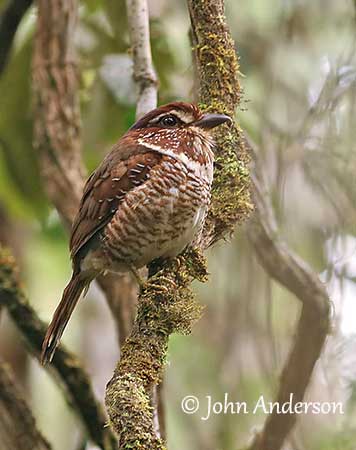
RANGE:
The Short-legged Ground-Roller is found in E Madagascar in forested areas, from Daraina and Tsaratanana massif in N, to Andohahela National Park in S, including some coastal areas in NW of the island and at the edge of the central plateau.
HABITAT:
The Short-legged Ground-Roller is mainly found at low and middle elevations in the humid parts of the rainforest. It favours undisturbed forest with large trees, damp soil and thick leaf litter, but with relatively open understorey. It may occur at edge of thick tangled vegetation but it avoids degraded forests.
CALLS AND SONGS: SOUNDS BY XENO-CANTO
The Short-legged Ground-Roller gives typical territorial low, resonant and hollow calls given in series of “whoop” or “hoop” sounds. It may sometimes produce a single “hoop” followed by fast, descending phrase “hoop-doodoodoodoodoodoo…” during 2-5 seconds. These calls are given from high perch with downward bobbing head, often prior to sunrise.
The contact call is a quiet “kroo-kroo” or a single “hoop” softer than the territorial call and given throughout the day.
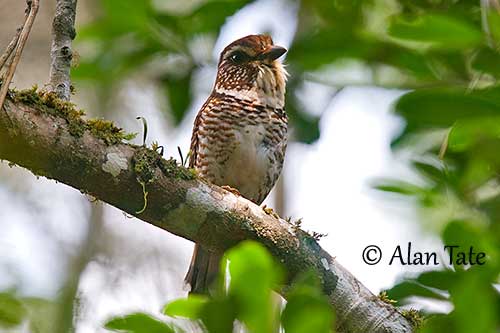
REPRODUCTION OF THIS SPECIES:
The breeding season takes place between September and February.
The Short-legged Ground-Roller is the only ground-roller that nests exclusively in tree cavities, whereas the other species nest in excavated burrows in the ground.
The first nest described was found in December 1996. A pair was nesting in a natural cavity in the dead branch of a tree. However, the breeding attempt was disturbed by a swarm of honey bees and failed.
But in the following month, the same pair excavated a new nest in the soft root mass of an epiphyte, 22 metres above the ground. Both adults made the excavation by taking turns. Both bill and feet were used, to excavate and remove the materials. This work took about one week.
The female lays 1-4, but usually 2 white eggs. She incubates alone while the male remains in the vicinity of the nest and occasionally feeds the female. The incubation lasts 22-26 days. The young fledge after a nestling period of about one month.
PROTECTION / THREATS / STATUS:
The Short-legged Ground-Roller is threatened by degradation and loss of the habitat through clearance for agriculture expansion. Deforestation is another threat and much of the forest on the E coastal plain is highly degraded. The remaining habitat is under pressure from increasing human population and commercial logging.
The population is roughly estimated to number 8,800 pairs in Masoala Peninsula alone. This would give a total of 3,900/9,800 pairs, equating to 7,800/19,600 mature individuals. This population is still declining.
The Short-legged Ground-Roller is currently listed as Vulnerable.
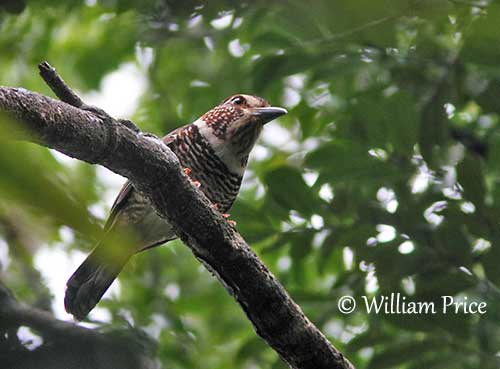
The Short-legged Ground-Roller is often seen in pairs and appears to be monogamous. They become territorial during the breeding season that extends from September to February. They give territorial calls and defend the territory.
During the courtship period, the male feeds continuously the female. It often perches beside her and preens the female’s head for several minutes prior to copulation. The male mounts her and copulates with wing flapping to keep its balance for one minute. During the courtship period, both mates travel around together in their territory.
The female incubates alone. She is fed by the male, but she leaves the nest sometimes to rest and forage around the nest-site.
The Short-legged Ground-Roller is probably sedentary with some movements related to weather conditions.
The flight is rapid and direct when the bird pursues a flying prey. Before to take-off, it often ruffles its feathers, flicks the wings and pumps the tail.
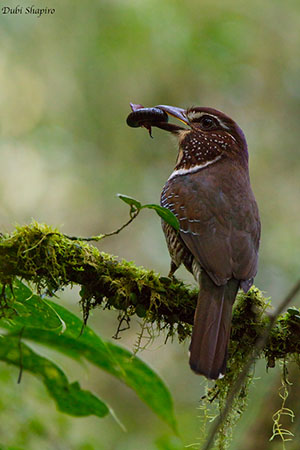
BEHAVIOUR IN THE WILD:
The Short-legged Ground-Roller feeds mainly on invertebrates such as ants and Myrmeleonidae ants, beetles and their larvae, caterpillars, butterflies, moths, cicadas, crickets, flies… and worms, snails, spiders, mantises and stick insects.
It also catches small vertebrates including small chameleons, geckos, frogs, lizards and snakes, and probably takes bird eggs.
The Short-legged Ground-Roller is more arboreal than other ground-rollers. It usually forages in canopy, perching motionless for long periods. It suddenly takes-off to catch a prey, picking it from a branch or the ground after a short flight. It also sally-gleans from foliage or twigs while flying. It may pursue a flying prey for more than 25 metres in spite of closed forest environment. It kills the prey by hitting it against a branch or by squeezing it with bill tip before to swallow it whole.
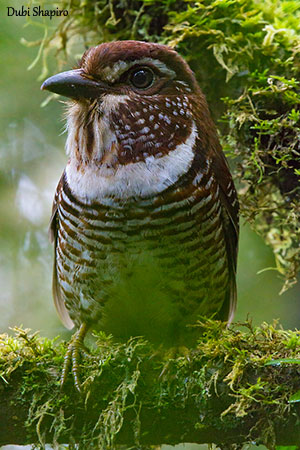
On the head, hindcrown and nape are bronzy-brown with violet-blue gloss. We can see a prominent whitish supercilium, and the eye’s area is dark brown. Sides of face are brown with white spotting. The feathers of the throat are often shaggy.
The stout, dark bill is slightly hooked, and has yellow cutting edge. Near the bill base, the nostrils are covered by rictal bristles. The gape is dull yellow. The eyes are brown. Legs and feet are brownish-yellow with pale claws.
Male and female have similar plumage, but the female is slightly smaller than male.
The juvenile is duller and browner. The crown is mottled with white and lacks the violet-blue gloss. The breast band is indistinct. Below, the feathers are brown-tipped (not barred) on lower underparts.
